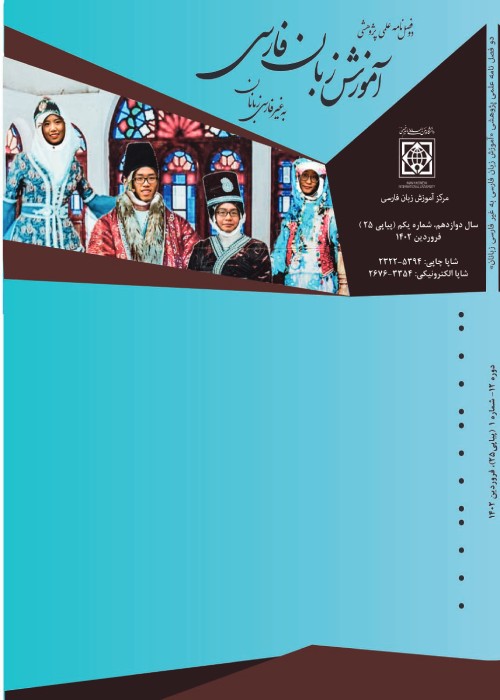Comparison of motivational level and motivational factors retrieved from Possible Selves theory and L2 Motivational Self System among Chinese and Lebanese Persian Learners
The key role of motivational factors in L2/FL learning is already acknowledged and knowledge of motivational attributes of language learners is very important in adopting appropriate teaching methods and compilation of more effective educational resources. The study aimed to compare the motivational attributes of Chinese and Lebanese Persian learners based onL2 Motivational Self System theory and the Possible Selves theory. For this purpose, two groups of 33 students were selected from Persian language teaching center of Qazvin. Theresearch instrument was a 36 item questionnaire which drew on the works of Tagouchi et al. (2009), Papi and Teimuri (2012) and Atarsharghi and Akbari (2019) with some modifications. Finally, 66 questionnaires were analyzed by SPSS 22 software. The results showed that there were significant differencesbetween Chinese and Lebanese learners in all of the motivational factors, except for anxiety, and the motivational level of Chinese students was higher than the other group. Regardingthe anxiety factor, there was no significant difference between the two groups. ForChinese students, themaximum and the minimum obtained indexes related to the ideal L2 self and the anxiety, respectively. In the case of Lebanese learners, themaximum and the minimum obtained indexes related to theprevention oriented factors and the ideal L2 self, respectively. Extended Abstract</strong> The key role of motivational factors in L2/FL learning is acknowledged since longtime; and recognition of motivational features of language learners is very important in order to adopt appropriate training methods and to compile more effective educational resources. The aim of this research was comparing the motivational factors among Chinese and Lebanese Persian learners based on L2 Motivational Self System theory of Dornyei and the Possible Selves theory of Markus and Nurius. This study intended to respond to 2 questions: 1- Is the motivational level of Chinese learners higher than Lebanese learnersin motivational factors including the ideal L2 self, the ought-to L2 self, the L2 learning experience, the intended effort, the instrumentality-promotion items and the attitudes to L2 culture and community? 2- Is the motivational level of Lebanese group higher than Chinese group in anxiety, the L2 willingness to communicate in class, and the effect of instrumentality-prevention items? Since the middle of 20th</sup> century, the L2/FL motivational studies were mainly based on Gardner and his colleagues' ideas (Gardner & Lambert, 1959; 1972; Gardner & Macintyre, 1993; Gardner & Tremblay 1994). And some specific terms were used by experts such as integrative- instrumental motivation, and later, intrinsic-extrinsic motivation. But at the end of the century, some imperfections of Gardner's model were revealed and it was determined that the person's imaginations, mental representations and beliefs of himself have a great effect on motivation of his activities.The theory of Possible Selves represents individuals' beliefs of what they might become, what they would like become, what they are obliged to become, and what they are afraid of becoming. Possible selves derive from representations of the self in the past and they include representation of the self in the future. Each individual creates sets of different possible selves in his psyche, according to his personal experiences and the effects of relatives, society, media, and etc. Possible selves represent specific individual hopes, fears and fantasies of the person (Markus &Nurius, 1986; Rocher-Hahlin, 2014). In the early 2000s, Dornyei and his colleagues integrated Gardner, Higgins, Markus&Nurius's ideas and presented the L2 Motivational System which is one of the most modern theories for studying the L2/FL motivation. This theory contains 3 main concepts: 1. The ideal L2 self, 2.the Ought-to L2 self and 3. The L2 learning experience. In this paper, in addition to these 3 motivational factors of Dornyei's theory, we studied 6 other motivational factors, based on possible selves concept, which were: 4. The intended effort, 5. The instrumentality- prevention items, 6. The instrumentality- promotion items, 7. The attitudes to L2 culture and community, 8.The L2 willingness to communicate in class and 9. The anxiety The statistical population of the research included at first 77 persons (37 Chinese and 40 Lebanese learners), but finally 2 groups of 33 persons of them were selected. The Lebanese students were all the Persian learners of the Persian Language Center of Imam Khomeini International University, with high school diploma or bachelor degree from Lebanon, who wanted to continue studying in different academic disciplines in Iran, after learning the Persian language. Chinese learners were all the students of Persian language and literature of Xi'an University in China 22 persons of whom had come to Persian Language Center for their third year of study, while 11 other ones stayed in China. The instrument of research was a questionnaire with 36 questions based on previous researches of Taguchi et al. (2009), Papi&Teimouri (2012) and Atarsharghi&Akbari (2019) with some modificatios. The data of 66 questionnaires were analyzed by SPSS 22 software. The demographic information about age and sex of each group was shown in Tables 2 and 3; and Figures 1 and 2. The results of calculating the Chronbach's alpha coefficient for each factor and for the whole questionnaire was in an optimal and acceptable range (ɑ> 0/7), and the reliability of research instrument was approved (see Table 1). The results showed that there were significant differences in all of the motivational factors, except anxiety, among Chinese and Lebanese learners, and the motivational level of Chinese students was higher than the other group. But there was not significant difference regarding the anxiety factor. The highest and the lowest averages of indices belonged to the ideal L2 self and the anxiety for Chinese students respectively, while for Lebanese learners the respective factors were the Instrumentality-prevention items and the ideal L2 self.
- حق عضویت دریافتی صرف حمایت از نشریات عضو و نگهداری، تکمیل و توسعه مگیران میشود.
- پرداخت حق اشتراک و دانلود مقالات اجازه بازنشر آن در سایر رسانههای چاپی و دیجیتال را به کاربر نمیدهد.


